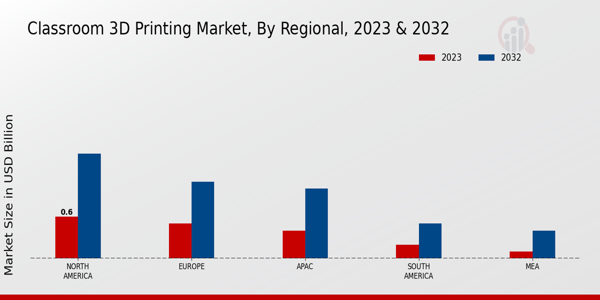Market Growth Projections
The Global Classroom 3D Printing Market Industry is poised for substantial growth in the coming years. With projections indicating a market size of 2.21 USD Billion in 2024 and an anticipated increase to 6.11 USD Billion by 2035, the industry is on a robust upward trajectory. This growth is fueled by various factors, including technological advancements, increased adoption in educational settings, and supportive government policies. The expected CAGR of 9.68% from 2025 to 2035 further underscores the market's potential as educational institutions continue to integrate 3D printing into their curricula.
Enhanced Learning Outcomes
Research indicates that the Global Classroom 3D Printing Market Industry contributes to improved learning outcomes for students. By facilitating experiential learning, 3D printing allows students to visualize complex concepts and engage in problem-solving activities. For instance, engineering and design students can create prototypes, while biology students can print anatomical models. These practical applications not only enhance understanding but also prepare students for future careers in STEM fields. As educational institutions increasingly prioritize skills development, the demand for 3D printing in classrooms is likely to grow, further driving market expansion.
Government Initiatives and Funding
Government initiatives play a crucial role in the growth of the Global Classroom 3D Printing Market Industry. Various countries are implementing policies and funding programs aimed at promoting STEM education and technological integration in schools. For example, grants and subsidies are being provided to educational institutions to acquire 3D printing equipment and training. Such support not only alleviates financial barriers but also encourages schools to adopt innovative teaching methods. As a result, the market is expected to witness significant growth, potentially reaching 6.11 USD Billion by 2035, driven by these supportive government measures.
Collaboration with Industry Partners
The Global Classroom 3D Printing Market Industry benefits from collaborations between educational institutions and industry partners. These partnerships often involve sharing resources, expertise, and technology, which enhances the educational experience for students. For instance, companies may provide 3D printing materials or software, while schools offer students real-world projects to work on. Such collaborations not only enrich the curriculum but also help students develop industry-relevant skills. As these partnerships become more prevalent, they are likely to contribute to the market's growth, fostering a more skilled workforce prepared for future challenges.
Rising Demand for Customization in Education
Customization in education is becoming increasingly important, and the Global Classroom 3D Printing Market Industry is well-positioned to meet this demand. 3D printing technology allows educators to create tailored learning materials that cater to diverse student needs and learning styles. For example, teachers can design specific models or tools that align with their lesson plans, enhancing student engagement and understanding. This flexibility in educational resources is likely to drive further adoption of 3D printing in classrooms. As the market continues to evolve, it is projected to grow at a CAGR of 9.68% from 2025 to 2035, reflecting the increasing importance of personalized education.
Increasing Adoption of 3D Printing Technology
The Global Classroom 3D Printing Market Industry experiences a surge in adoption as educational institutions recognize the potential of 3D printing technology to enhance learning experiences. Schools and universities are increasingly integrating 3D printers into their curricula, allowing students to engage in hands-on projects that foster creativity and innovation. This trend is supported by the growing availability of affordable 3D printers, which are becoming more accessible to educational institutions. As a result, the market is projected to reach 2.21 USD Billion in 2024, indicating a robust growth trajectory as more educators embrace this transformative technology.





















